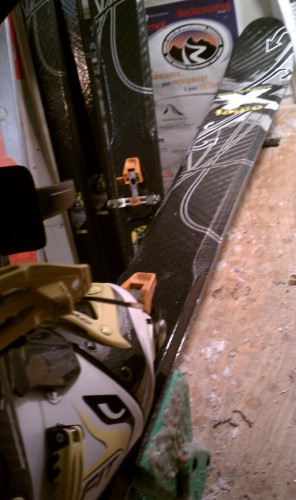“Are those for your Movement Goliath Sluff skis?” my friend jokingly asked of some high-DIN all-metal bindings on my work bench (actually destined for Super G skis). At the time I didn’t even realize that he had incorrectly combined the names of two different Movement models, but, whatever, all their models were hefty freeride” skis, so, same difference, right?
I was therefore very surprised when another friend who is perpetually envious of my Trab Duo Sint Aero skis asked me about Movement, which boasts some highly competitive specs in the lightweight yet narrow ski mountaineering category.
I was then utterly shocked by the Movement Logic X-Series with a width:weight ratio that seemed downright impossible.
I know some of you are going to scoff that even a ski 88mm in the waist is still too narrow. But they can work well. I produced a chart summarizing the various offerings in this range:
A few of the models are pushing the upper end of the lightweight characteristic, but most are pretty close to each other. The Dynafit Mustagh Ata Superlight had stood out until now as the lightest, but the Movement Logic-X specs almost look like a misprint.
And indeed those specs are incorrect, even outside of the +/- range Movement cites. But if anything I was relieved rather than disappointed: at 4 pounds 9.8 ounces for an 88mm-waisted 168cm, any lighter and I really would have doubted their descent abilities!
So how do they ski? As fellow guest blogger Lee Lau commented in his Dynafit Stoke review, a ski should be tested in its intended conditions (i.e., a backcountry powder ski in backcountry powder, not lift-served groomers). The problem with such a review basis for skis in this category is that they’re intended as a compromise across all conditions, and thus trying out the Logic-X in all conditions is going to take awhile.

Movement Logic-X, being mounted for Dynafit TLT5 Performance boots, using Speed bindings pieced together from a half-dozen sources, with Fish race skis in the background
Now for my previous experience with a ski in this all-rounder lightweight category, I found the Dynafit Mustagh Ata Superlight to be capable across the spectrum of horrible sastrugi, chalky windslab, steep refrozen nastiness, weird moguls — plus some nice corn. On my second outing with them. All in a single run. (Hurray for New Hampshire’s Mount Washington!)
I doubt I will be so “lucky” with test conditions for the Logic-X, but so far I’ve skied them on good firm snow, soft yet fairly consolidated snow, nasty ice, and even nastier chunky refrozenness. Yes, on my very first run with them. The Logic-X definitely performs well on anything firm. For softer snow impressions, stay tuned.
Otherwise, some minor quibbles for a design obviously appealing to ski mountaineering applications are the lack of a hole in the tip (for sled construction) and a somewhat upturned tail (thereby hindering anchor applications). I’m also wondering if the base doesn’t hold wax all that well, although this might be the new skins stripping off wax more quickly, but something about the base just always seems “dry” almost immediately after hot waxing. And the camber is traditional, with no tip rocker or early rise or whatever you want to call it. Whether the new trend in tip camber will trickle down to become ubiquitous in skis with these dimensions is of course entirely speculative, but I did notice that K2 has tweaked the tip of its Wayback entry in this category for this season.
Rounding out the X-Series line, the even lighter Random-X has dimensions that compete with the Dynafit Broad Peak and my beloved Trab Duo Sint Aero. The Fish rando race model isn’t any lighter than its competition, but with my 162cm pair weighing in at only 3 pounds 1.6 ounces, any lighter and it might just float away. (More on that later this season once I mount them up for my DyNA boots.)
(WildSnow guest blogger Jonathan Shefftz lives with his wife and daughter in Western Massachusetts, where he is a member of the Northfield Mountain and Thunderbolt / Mt Greylock ski patrols. Formerly an NCAA alpine race coach, he has broken free from his prior dependence on mechanized ascension to become far more enamored of self-propelled forms of skiing. He is an AIARE-qualified instructor, NSP avalanche instructor, and contributor to the American Avalanche Association’s The Avalanche Review. When he is not searching out elusive freshies in Southern New England or promoting the NE Rando Race Series, he works as a financial economics consultant.)
WildSnow guest blogger Jonathan Shefftz lives with his wife and daughter in Western Massachusetts, where he is a member of the Northfield Mountain and Thunderbolt (Mt. Greylock) ski patrols. Formerly an NCAA alpine race coach, he has broken free from his prior dependence on mechanized ascension to become far more enamored of self-propelled forms of skiing. He is an AIARE-qualified instructor, NSP avalanche safety instructor, and contributor to the American Avalanche Association’s The Avalanche Review. When he is not searching out elusive freshies in Southern New England, he works as a financial economics consultant.

